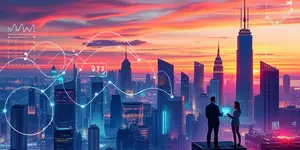In an era of rapid digital transformation, consumers are faced with a fundamental choice: embrace the innovations of fintech or stick with the familiar practices of traditional banks. Both models offer unique advantages and potential drawbacks, making the decision highly personal. This guide dives deep into definitions, comparisons, statistics, and practical advice to help you choose the option that best aligns with your financial needs and lifestyle.
Understanding Fintech and Traditional Banking
Financial Technology, commonly known as fintech, is revolutionizing the way we manage money by leveraging cutting-edge digital tools. From mobile apps powered by AI to blockchain-based platforms, fintech companies focus on digital-first, app and web-driven structure to deliver highly specialized financial services. These services range from peer-to-peer lending and robo-advisors to real-time payment processing and automated budgeting tools.
Traditional banks, on the other hand, are institutions with deep-rooted histories and broad service portfolios. They offer everything from checking accounts and mortgages to wealth management and safe deposit boxes. Operating under heavily regulated, insured frameworks, these banks emphasize in-person support, physical branch networks, and a track record built on trust and stability.
Core Differences at a Glance
Understanding the distinctions between fintech and traditional banking can clarify which model aligns with your priorities, whether that’s speed, cost, personalization, or security.
Pros and Cons Comparison
While fintech and traditional banks both aim to serve financial needs, their strengths and weaknesses differ markedly.
- Fintech Advantages:
- 24/7 digital access with no physical branches
- Real-time processing and instant approvals
- No or minimal fees for many transactions
- Innovative features like AI budgeting tools
- Traditional Banking Advantages:
- Physical branches for in-person support
- Comprehensive service offerings under one roof
- Strong regulatory oversight and deposit insurance
- Established reputations and legacy trust
- Fintech Drawbacks:
- May lack the full range of banking services
- Less face-to-face interaction and support
- Variable regulation can raise compliance concerns
- Potential cybersecurity vulnerabilities
- Traditional Banking Drawbacks:
- Slower processes due to legacy systems
- Higher fees for maintenance and transactions
- Limited hours and branch locations
- Less personalized digital experiences
User Considerations: Which Path Suits You?
Your choice between fintech and traditional banking should reflect your financial goals, comfort with technology, and need for personal support.
- Convenience-Seekers and Tech Enthusiasts: Prefer apps and instant approvals, low fees, and highly personalized and tech-driven experience.
- Fee-Conscious Consumers: Value minimal costs for everyday transactions and peer-to-peer payments.
- Risk-Averse and Relationship-Focused Clients: Lean toward robust consumer protections, insured deposits, and face-to-face service.
- Complex Financial Needs: Require integrated wealth management, multiple loan products, and in-person advisory services.
Market Trends and Industry Insights
The financial sector is undergoing a seismic shift, driven by consumer expectations and technological breakthroughs. In 2025, the global fintech market is valued at over $209.7 billion, with a projected CAGR of 25.18% through 2032. Digital payments alone are expected to top $20.37 trillion in 2025, underscoring the scale of this transformation.
Investment flows into fintech exceeded $43.5 billion in 2024, and there are now 414 fintech unicorns worldwide. Notably, decentralized finance (DeFi) platforms hold more than $118.63 billion in assets, pioneering new models of financial intermediation without traditional banks.
Generative AI boosting productivity by 30 percent in the financial sector highlights how emerging technologies can redefine customer interactions, risk assessment, and back-office operations. As banks adopt more AI, machine learning, and blockchain solutions—often in partnership with fintech startups—they aim to narrow the innovation gap and meet rising consumer demands.
Innovation, Collaboration, and Future Outlook
Rather than fierce adversaries, many traditional banks and fintech firms are finding common ground through strategic partnerships. Banks contribute regulatory expertise and capital, while fintechs inject agility and fresh user experiences. This synergy has produced hybrid offerings such as digital-only banking arms backed by established institutions.
Looking ahead, financial services will likely blend the best of both worlds: the trust and security of banks with the speed and personalization of fintech. As open banking initiatives and API-driven ecosystems expand globally, consumers will gain greater control and choice over how their data powers tailored financial solutions.
Security, Regulation, and Trust
One of the primary distinctions between fintech and traditional banking lies in the regulatory landscape. Traditional banks operate under rigorous frameworks, with insured deposits and mandatory capital reserves. Fintech firms, depending on region and service, may navigate a patchwork of regulations, which can create uncertainties for consumers and institutional partners.
For risk-averse customers, the assurance of deposit insurance and formal dispute resolution mechanisms may tip the scales toward traditional banks. Conversely, tech-savvy users confident in cybersecurity protocols may prioritize fintech offerings that emphasize encryption, biometric authentication, and continuous risk monitoring.
Conclusion: Choosing the Right Option
Your decision between fintech and traditional banking ultimately depends on balancing key factors:
Personal Goals: Are you seeking fast, low-cost solutions or comprehensive, relationship-based services?
Technology Comfort: Do you embrace mobile-only experiences or prefer occasional in-person interactions?
Service Requirements: Do you need specialized tools for investing and budgeting, or diverse lending and deposit products under one roof?
Trust and Security: Is insured, regulated protection paramount, or do you trust emerging cybersecurity innovations?
By reflecting on these questions, you can align your banking relationship with your lifestyle and financial aspirations. Whether you choose the nimble world of fintech or the established realm of traditional banks, understanding each model’s strengths will empower you to maximize value, convenience, and peace of mind in managing your money.
References
- https://www.grasshopper.bank/who-we-are/blog/digital-banks-vs-traditional-banks-vs-fintechs-what-sets-them-apart/
- https://www.chase.com/personal/banking/education/basics/fintechvstraditional-banking
- https://digitaldefynd.com/IQ/fintech-vs-finance/
- https://www.associatedbank.com/education/articles/personal-finance/banking-basics/banks-vs-fintech-which-is-better
- https://www.jellyfishtechnologies.com/fintech-vs-traditional-bank-innovations-in-financial-technology/
- https://fortunly.com/statistics/fintech-statistics/
- https://www.tatvasoft.com/outsourcing/2021/04/fintech-vs-traditional-banks.html
- https://payhawk.com/en-us/blog/fintech-vs-traditional-banking-for-cfos










